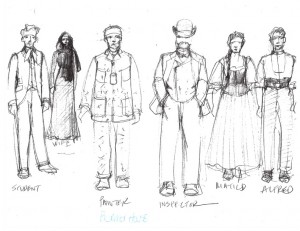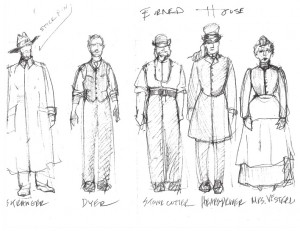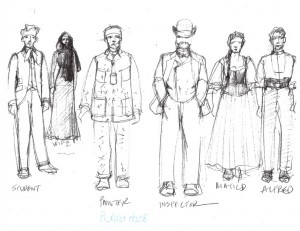Press play to watch an introduction by director
Rob Melrose

SCENE ONE
The play opens with a detective questioning a witness about a fire. As he digs in the ruins of a house that burned down the night before, the witness – an old mason named Andersson – tells the detective that in this quarter called Morass, “anyone who comes [here] once never leaves, at least those who do leave always come back sooner or later, till they’re driven out to the graveyard down at the end of the road.” According to the mason, in Morass, “everyone hates everyone, mistrusts everyone, slanders everyone, [and] torments everyone.” As the detective relentlessly badgers Andersson for more information that could help him determine how the fire started, Andersson grows more unwilling to answer the detective’s questions. The mason says that he wants to take back everything he said as there was no one to witness to his conversation with the detective. The detective summons a witness he had hiding behind a building, thereby preventing the mason from recanting his testimony.
The detective and the witness exit. Andersson’s wife enters with lunch for the mason. Mrs. Vesterlund, a bartender who escaped the fire, also arrives. As the three discuss the damage caused by the fire, Mrs. Andersson’s cousin, a hearse driver, arrives to tell them that a monument for a bishop is being erected in the graveyard. As the hearse driver leaves, the mason goes back to digging. When his wife asks him if he found anything, he mentions that the keys to the house had been hanging on the door post. His wife infers that “someone locked all the doors and took the keys out before the fire started,” suggesting that the fire may have been arson. Mrs. Andersson then describes the unhappy, quarrelsome Valström family that lived in the burned house. According to Mrs. Andersson, “the father was an honest man, but the boys [Arvid, who moved to America, and Rudolf, a dyer] were so-so.”
Gustafsson, a gardner and Andersson’s cousin, enters, berating himself for not insuring his damaged property and for going out to drink the night before. Since Gustafsson’s son is supposed to marry the stonecutter’s daughter this evening, Gustafsson’s losses weigh all the more heavily on him. As Gustafsson laments that he told the detective more than he probably should have, a stranger enters, inquiring about the price of the wreaths that Gustafsson is selling. The stranger is Arvid Valström, the brother of the dyer who now owns the now-burned house. After discovering that his childhood home is in ruins, Arvid leaves. In a frenzied state of distress, Gustafsson leaves to get supplies for the wedding.

Rudolf Valström arrives to ask Andersson the mason whether he had uncovered any evidence that reveals how the fire was started. When Andersson says there is no new evidence, Rudolf deplores that everyone is then still a suspect – “[Andersson] and the stonecutter, and the gardener, and Madam Vesterlund, even the painter there, all are suspects, and the student and the cook and me most of all.” The mason and his wife exit just as Arvid Valström arrives, much to Rudolf Valström’s surprise. Arvid reminisces nostalgically about objects he discovers in the ruin of the burned house, and tells Rudolf about his adventures abroad. The brothers begin to come to terms with the fact that although their family had once been highly regarded, there is ample evidence to suggest that they were smugglers. Arvid points to the charred remains of “double walls” that had been used to hide stolen goods. Arvid tells Rudolf that he learned about the family’s shameful past in America, where he ran into their schoolmate, Albert Eriksson – a relative of the stonecutter. A little later, Arvid reveals that he once tried to hang himself in the closet. Rudolf is struck by how little they knew about their own family and how little they now know about each other. Arvid then tells Rudolf that their family’s dubious history had been reported in a newspaper article about the fire, and that the author had also suggested that Rudolf’s wife was romantically involved with the student who lived on the second floor since hairpins were discovered on the floor of the student’s room.
The stonecutter and the detective arrive at the scorched house, postulating that the fire started with a particular lamp in the cook’s closet. Rudolf identifies the lamp as the student’s. The detective says that the student will be arrested on suspicion of arson. As the detective and the stonecutter depart, the brothers decide to go for a walk in the garden.
SCENE TWO
The stonecutter, the Anderssons, Gustafsson, the hearse driver, Mrs. Vesterlund, and a painter named Sjöblom stand together, examining the burned lot where the walls have now been torn down. Arvid enters and scares off the crowd by saying that there could be dynamite in the basement. Arvid examines a heap of remnants from his past such as “the frame from [an] old family portrait… part of the frame of the mahogany bed in which [Arvid] was born, [and] the parlor clock,” all of which spark a new stream of memories. As the clock disintegrates, Arvid contemplates that “nothing stands up to inspection.”
The student returns and lingers by the ruins waitng for someone. Arvid immediately begins accusing him of planting the lamp to start the fire. Arvid informs the unnerved student that he is to be arrested. As the student leaves, Arvid wonders aloud whether or not the student is his son.
The painter, Sjöblom, enters and recognizes Arvid. The painter accuses Arvid of destroying his artistic career as a boy by revealing that he was color-blind. When Arvid refuses to apologize, the painter leaves in an indignant huff. Mrs. Vesterlund enters. Arvid starts to reminisce with her about her late husband, Mr. Vesterlund. Arvid has fond memories of Mr. Vesterlund, but over the course of the conversation realizes that he was not a kindly man but sarcastic and manipulative. Mrs. Vesterlund does not deny that her husband was unkind, but is upset that Arvid is bringing up his memory all the same. When Arvid says that it was nice to meet her again, Mrs. Vesterlund says “people should never meet again [because] it’s not the same as before.”
Eriksson, the stonecutter, arrives. Arvid asks the him whether they have ever done one another harm. The stonecutter says that his father worked for the customs office and was fired when he could not convict Arvid’s father of smuggling. Arvid questions the stonecutter about the fire. The stonecutter admits that he knows that the student, who has been arrested, is innocent, but says that “the only witness who could prove his innocence would thereby prove her own guilt — for something else.” The stonecutter refuses to reveal who this witness is, but provides Arvid with the clues that she owns the hairpins that were found in the fire and that she’s not the cook. He tells Arvid that the student’s “worst enemy” started the fire. The stonecutter also suggests that only the mason, Andersson, who knows many secrets about the house, is the only person who knows who started the fire. Arvid questions the stonecutter about Mrs. Vesterlund’s character, and he replies with cryptic answers before leaving so as not to embarrass his daughter, Matilda, and her fiancée, Gustafsson’s son, Alfred, who are approaching.

Matilda and Alfred look at the burned house, recalling the memory of the fire. Matilda is upset, assuming that her father-in-law, the gardner, is financially ruined by the fire and that the wedding has been postponed. Alfred tells Matilda that his father is more shrewd than he appears and has more than enough money saved. He also assures Matilda that they will indeed be married that evening – the wedding was only postponed for two hours so that his father could find a new coat, not because his finances had been obliterated. Matilda is shocked to learn that Alfred’s father is well-off; she resents Alfred for not telling this to her before and wonders whether she can ever trust him again. They exit hand in hand. As they exit, Arvid applauds.
The detective enters to speak quietly with Arvid, then exits. Rudolf’s wife, Arvid’s sister-in-law, introduces herself to her brother-in-law. She agrees with Arvid’s descriptions of Rudolf as a cowardly braggart. Arvid realizes that it is Rudolf’s wife whom Eriksson referred to as the one witness who could save the student, concluding that the student and the wife must be having an affair. Arvid empathizes with Rudolf’s wife and agrees to help her.
As the wife exits, her husband returns. Arvid informs Rudolf that the dectective told him the insurance payment had been received two hours too late. Rudolf miserably moans that he is “ruined.” As the play ends, Arvid accuses his brother of positioning the lamp. Rudolf does not deny the accusation. Arvid urges him to find a job in the real world instead of reaping wealth from his insurance benefits. As Arvid prepares to leave, he sighs, “And so: back into the world, wanderer.”
